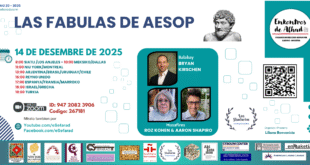
The conversion and kidnapping of Sefardic children in 1493 in Portugal is a footnote in Jewish history, studied only by scholars.
Produced by the Jewish Community of Porto, Portugal, and the Madrid-based Hispano Jewish Foundation, the docudrama, which can be viewed for free online, starts with the publication of the Edict of Expulsion of the Jews from Spain, issued in the city of Granada on March 31, 1492.
The first scenes show the Jews marching towards Portugal, one of the places where the expellees hoped to find refuge among their brethren after the expulsion.
The entrance to the country was negotiated by rabbi Isaac Aboab, the last Gaon of Castile, and the Portuguese king Joao II. The Jewish community was allowed to stay for eight months and pay eight cruzados per person.
Jews who couldn’t show proof they had paid the fee or those who had overstayed the prescribed time were enslaved by the Portuguese authorities and their children taken away. The constant harassment from the local population, who echoed the Catholic priests’ fanaticism, fostered hatred towards the new arrivals.
In 1493, the children of the enslaved Jews were first converted to Catholicism and then shipped along with criminals to the island of São Tomé, in the Gulf of Guinea, off the western coast of Africa, which Portugal discovered in 1470. The trip lasted a month-and-a-half.
A Portuguese colony until 1975, the island, far from being a paradise, was populated by huge crocodiles and covered by a dense jungle. A volcanic island, its toxic gases were another hazard the children had to deal with as well as the intense heat.
The acting is excellent and the scenes and costumes of 15th-century Portugal were superbly recreated.

The narration is in English. The dialogues, in Spanish and Portuguese, have English subtitles.
According to the 30-minute film, some 1,400 children died during the journey or in the early days on the island.
One of the medieval chroniclers who wrote about the tragedy was the Spaniard Samuel Usque, whose descriptions and those of other contemporary historians served as the basis for the script.
In his famous book Consolaçam as Tribulaçoens de Israel (Consolation for the Tribulations of Israel), published in Portuguese in 1553, he wrote:
[…] São Tomé [ . . .] was inhabited by lizards, snakes and other venomous reptiles, and devoid of rational beings. Here the king exiled condemned criminals, and he decided to include among them the innocent children of these [enslaved] Jews.
[. . .] When the luckless hour arrived for this barbarity to be inflicted, mothers scratched their faces in grief as their babies, less than three years old, were taken from their arms. […] The fated children raised their piercing cries to heaven as they were mercilessly torn from their beloved parents at such tender age.
[…] Finally, when these innocent children arrived in the wilderness of São Tomé, which was to be their grave, they were thrown ashore and mercilessly left there. Almost all were swallowed by the huge lizards and the remainder, who escaped those reptiles, wasted away from hunger and abandonment. Only a few were miraculously spared their dreadful misfortune.”
Rui de Pina, chief chronicler of Portugal in the 1500s, also wrote about the calamity in his book Chronica D’El Rey Don Joao II, published in Lisbon in 1792.
Garcia de Resende, chronicler and chamber attendant to King Joao II, devoted a chapter to the tragedy in his Chronica dos Valorosos e Insignes Feitos del Rey Dom Joam II (Chronicle of the dos Valorous and Distinguished Deeds of King Joao II. The book was published in 1798.
A contemporary author, David Raphael, touches upon the topic in The Alhambra Decree, a novel abut the Expulsion, published in 1988, and The Expulsion 1492 Chronicles, an anthology of medieval chronicles selected edited by him and published in 1992 that includes the chronicles of Usque, de Pina and Resende.
The film can be viewed at https://www.youtube.com/watch?v=5dmff7yl4Uc&t=316s
Fuente: kolsefardim.net
 eSefarad Noticias del Mundo Sefaradi
eSefarad Noticias del Mundo Sefaradi

